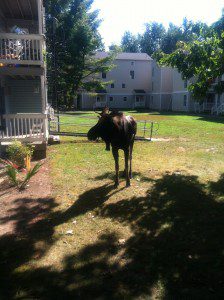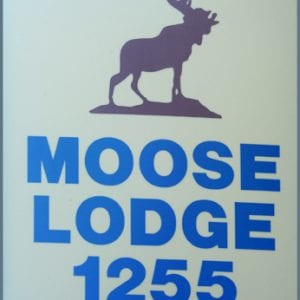
A moose drew crowds and led police and animal control officers on a chase on the north side of the city last week. (Photo by Peter Francis)
WESTFIELD – Some city residents have expressed reservations about the way officials responded to a complaint of a moose which was at large in the Union Street area of the city last week.
The moose was first sighted on Holyoke Road and was next found in the area of Powder Mill Village on Union Street.
Ken Frazer, the director of animal control operations in the city, said that he believes the bull moose was tracking a moose cow.
“He was looking for the cow that came through two weeks ago” Frazer said and said that the moose was in rut.
Frazer said that by 12:30 p.m. the moose had moved away from people and was in a gully at the end of Carpenter Street.
He said that he left the moose there “to let it go on its own” about 1:30 p.m. but at 3:15 p.m. a resident reported that the moose was in her driveway and was hazard for children returning from school.
Frazer said that, when he returned, he found the moose lying down in the grass and that the 750 pound moose did have the potential to be dangerous.
“He charged me three times, he charged (Officer) Harry (Sienkiewicz) once,” Frazer said and went on to say “He’s in rut, all he’s got on his mind is one thing.”
“He’s going to be doing a lot of stupid things” so action had to be taken, Frazer said.
The environmental police were summoned and the first officer arrived at about 4 p.m.
Frazer said that the environmental police scouted the area and found that a fence was blocking the moose’s access to the river leaving it no other option than to return through the densely populated Union Street area.
Amy Mahler, a spokesperson for the Environmental Police, said that the moose “couldn’t be hazed from the area” so the options were limited.
Mahler and Frazer both said that the moose could not be tranquilized and transported to a safe area because of concerns that the moose might be hunted and eaten.
Both said that the tranquilizing medication is toxic to humans and remains in a moose’s bloodstream for at least 30 days making illness or death a real possibility for anyone who consumed meat from a previously tranquilized animal.
Suggestions that the moose could be sequestered, perhaps in a zoo, do not appear to be practical.
John Lewis, an official at the Forest park Zoo, said that although the zoo has housed wild animals temporarily the past the zoo has never hosted an animal as large as a moose.
He said that an enclosure for a moose “would need a substantial perimeter to keep it from injuring itself.”
In addition, Lewis said “There is the problem of relocating it. In order to do that it would have to be knocked down (again) and transported to a location where it won’t come down to civilization and hurt itself or the public.”
Lewis said that he believes that “the normal drugs used for transporting animals usually disappears in a 5-7 day period” so, although the period when the moose would be danger to anyone who eats it is shorter, the hazard cannot be eliminated by boarding a moose until tranquilizing drugs leave its system.
Unable to leave the moose in place where it could be a hazard to the public and unable to relocate it safely, the environmental police had little choice but to kill the animal.
“The policy we have in place is that we want people to be as safe as possible” Mahler said.
Frazer said that, although he regrets the necessity, “I think they did the right thing.”




